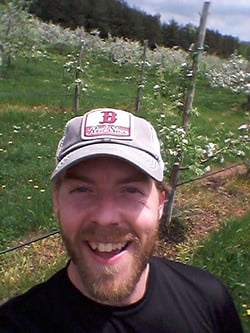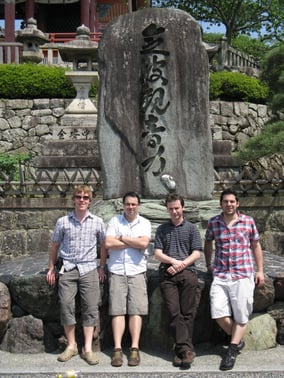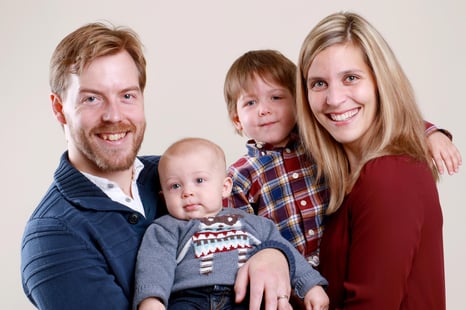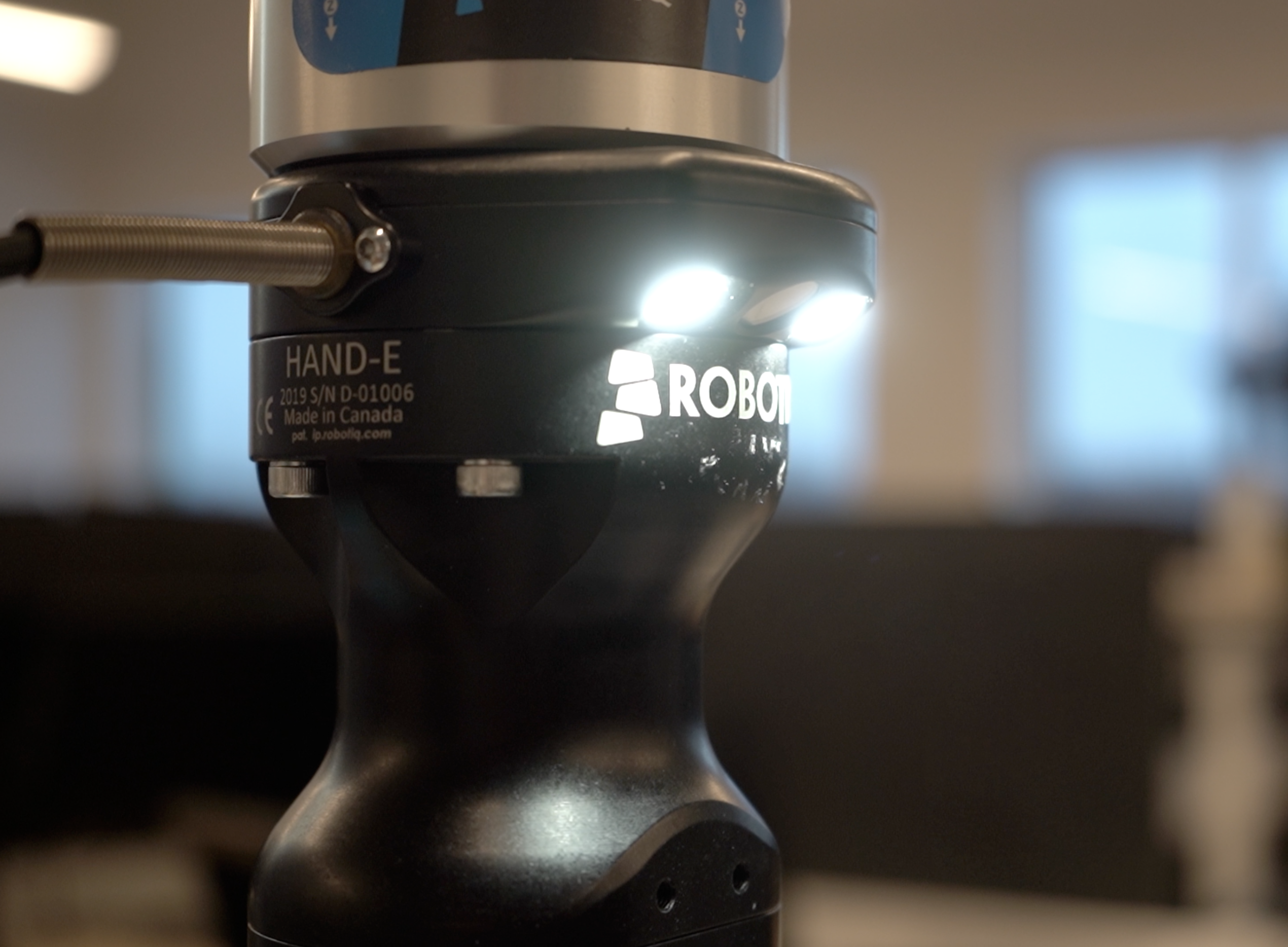Across the River From His Family's Farmland, he Designs Robotics: Introducing Louis-Alexis Allen Demers

Louis-Alexis Allen Demers grew up nearby on an apple orchard. His family’s history runs deep in this town. At Robotiq, his product designs help trace the history of this company.
Robotiq was founded after lab-mates Samuel Bouchard, Vincent Duchaîne and Jean-Philippe Jobin decided to commercialize some of the mechatronic work they and their professor Clément Gosselin had created at Laval University in Quebec City. That was in 2008.
Today, Robotiq counts more than 50 full-time staff, and our Grippers and sensors operate in 40 different countries. We felt it was time to start telling the stories of our team members.
Louis-Alexis Allen Demers’s grandfather used to bring his cows to pasture on the land where Robotiq’s building stands today. The old and the new, the traditional and the innovative, run through Louis-Alexis’s work and life.
 While robotic arms have replaced heads of cattle in this particular location, there’s an orchard and surrounding forest nearby that his parents still own. Louis-Alexis sometimes takes a run from work through that forest, passing by his cousin’s strawberry fields, to pay a visit to his parents. The Demers family goes back to the founding, in 1694, of St-Nicolas, which is now a district in the Quebec City suburb of Lévis, and where Robotiq has set up shop.
While robotic arms have replaced heads of cattle in this particular location, there’s an orchard and surrounding forest nearby that his parents still own. Louis-Alexis sometimes takes a run from work through that forest, passing by his cousin’s strawberry fields, to pay a visit to his parents. The Demers family goes back to the founding, in 1694, of St-Nicolas, which is now a district in the Quebec City suburb of Lévis, and where Robotiq has set up shop.
Louis-Alexis’s history with Robotiq goes back to before the company’s founding. He, Vincent, Jean-Philippe and Samuel were all part of Laval University’s now-iconic robotics lab and were shaking the fences of an industry ready for breakthroughs.
Vincent and Samuel, along with Jean-Philippe, would go on to found Robotiq, while Louis-Alexis would continue his university research, which included designing robotic hands. Once he earned his PhD in 2011, he transitioned naturally into a company that required a person like him who had already spent so many waking hours improving the capabilities of robotic arms.
Louis-Alexis played an integral part in the design of every product innovation at Robotiq: The economical and efficient 2-Finger Gripper, the Force Torque Sensor, with its ability to measure pressure and give it a sense of touch, and the addition of a Wrist Camera to the Gripper that now has a vision system. They all went to market on his watch.
Robotiq in 2017 has him overseeing new product designs, as well as design changes to existing products. His long association with Robotiq, and robotics in general, means he knows the company’s products from their earliest iterations and can tease out further efficiencies.
The company that provides for his family’s future is located on the land of his family’s past, while his intricate knowledge of Robotiq product designs –his more recent past – is on offer to a company looking to the future.
Meet Louis-Alexis Allen Demers: Mechanics Technical Leader at Robotiq
.jpg?width=458&name=IMG_0619%20(1).jpg)
Louis-Alexis grew up on an apple orchard. His family worked the land during the summer, while the rest of the year he and his four siblings went to school and his parents taught in the local Cegep, or junior college. His father, a physics teacher, used his teaching talents on his children. Louis-Alexis remembers a school field trip to a local waterfall. Ten at the time, he found himself explaining how hydroelectricity worked to his classmates. “My teacher asked me ‘How do you know such things?’ and I said: ‘My father explained it.’”
His mother, meanwhile, was a child psychologist, who would often bring home games to help spur her children’s creativity. Like most future engineers, Louis-Alexis preferred playing with Lego. As he got older, little plastic pieces would be replaced by wood, rope or metal for various projects. He recalled how he, his brother and cousin took parts from three old bikes to make a go-cart. And as a teenager, he and his brother built makeshift houses in the woods for them to camp in overnight.
As a high school student, he was fascinated with the International Space station, whose first module was launched in 1998. “That was one of the great projects that brought people and countries together,” he said. So great, that it inspired him to be an engineer. He would go on to take pure and applied sciences in Cegep and later enroll in mechanical engineering at Montreal’s École Polytechnique. After a year of commuting to see his girlfriend Valérie (now his wife), who was studying in Quebec City, and the realization that Laval University could offer him the same engineering degree, he moved back to his home town. Studying at Laval would prove fortuitous.
 In both Cegep and university, he participated in aeronautical projects, including a cargo plane and glider. But he soon realized that small team projects, where each person plays a large role, differs greatly from the aerospace profession, where he would be one of hundreds of engineers on an assignment. “I figured out that if I wanted to be a designer project leader and make a difference, it would be hard to do in the aeronautics field.”
In both Cegep and university, he participated in aeronautical projects, including a cargo plane and glider. But he soon realized that small team projects, where each person plays a large role, differs greatly from the aerospace profession, where he would be one of hundreds of engineers on an assignment. “I figured out that if I wanted to be a designer project leader and make a difference, it would be hard to do in the aeronautics field.”
Robotics, with its connection to both aeronautics and manufacturing, caught his fancy, as did the innovations taking place in Laval’s robotics lab. Among the students hanging out at that lab in 2006 were four people who would play important roles in his future: Samuel Bouchard, Vincent Duchaine and Jean-Philippe Jobin, who would soon launch Robotiq, and Nicolas Lauzier, the company’s eventual head of R&D. During his Master’s degree, he co-organized an aeronautics fair with Samuel and Vincent, with whom he also shared some business courses.
Robotiq’s first years of operation and Louis-Alexis’s PhD research dovetailed, not only in their timing but in their content. He worked on an underactuated robotic Gripper, the same technology used in Robotiq’s maiden product. For his five-finger Gripper, he worked on making it anthropomorphic and using significantly fewer actuators (electrical motors) to move the fingers’ “muscles.”
 The PhD student would run into the Robotiq founders in the lab and talk robotics. They would ask when he was finishing his studies and take interest in his findings. The partners would continue to follow his work that took him to Japan, China, Mexico and the US to present papers. It was on one of those trips in 2011 when he started to feel that Robotiq would soon become his employer. “Someone asked me what my plans were and I said that in a few months I’ll be working at Robotiq.”
The PhD student would run into the Robotiq founders in the lab and talk robotics. They would ask when he was finishing his studies and take interest in his findings. The partners would continue to follow his work that took him to Japan, China, Mexico and the US to present papers. It was on one of those trips in 2011 when he started to feel that Robotiq would soon become his employer. “Someone asked me what my plans were and I said that in a few months I’ll be working at Robotiq.”
In fact, it was mere weeks later that he was hired, and hard at work on the 2-Finger Gripper. The project had him building a leaner, less costly end-of-arm tool that would find a wider customer base and help the company establish their degrees-of-freedom philosophy.
His work at Robotiq has focused on mechanical design. He has built new products, working closely with electrical and software specialists. He loves working on tangible products, just like when he was with his brother and cousin building a go-cart or inside the Laval lab testing out an oscillating wing that generated electricity from ocean waves. That’s an aspect of his profession that he loves: “When we see the stuff that we thought of and imagined; when we have it in our hands it’s an incredible feeling.”

All Robotiq product modifications pass through Louis-Alexis. As the fourth person to be hired in the company, his institutional knowledge and design vocabulary have helped the company accomplish product developments and transform it into a world player. But he credits the company for putting out both updated and new products so quickly.
“We’re very efficient. When I talk to other friends in engineering and I say that in March there was nothing and then three months later we made it, tested it and now we’re selling hundreds of them, they’re amazed.”
Louis-Alexis has a young family now with Valérie, raising their two sons, who are one and three and a half years old. "The company makes sure that everyone is with their kids on the weekends,” he says of a corporate culture that takes work-life balance seriously. And those weekends have been filled with family time for the couple, who have had to trade their past international travels for walks in the forest around the family apple orchard.

Louis-Alexis loves the fact that the family forest is separated only by a river from Robotiq’s factory. “When we moved in 2011 from the old place, it was strange that they chose to be here. It was strange for me and for my father and grandfather, for us to see life come full circle.”







Leave a comment